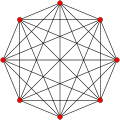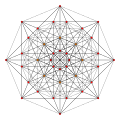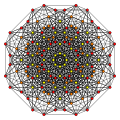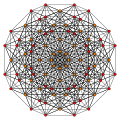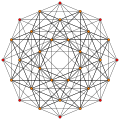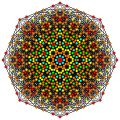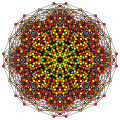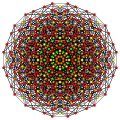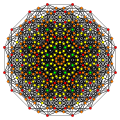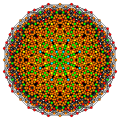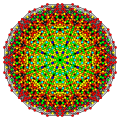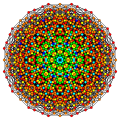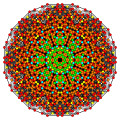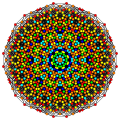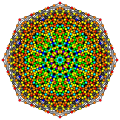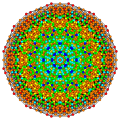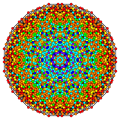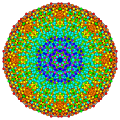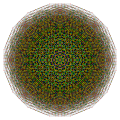Top Qs
Timeline
Chat
Perspective
Rectified 7-simplexes
Convex uniform 7-polytope in seven-dimensional geometry From Wikipedia, the free encyclopedia
Remove ads
In seven-dimensional geometry, a rectified 7-simplex is a convex uniform 7-polytope, being a rectification of the regular 7-simplex.
There are four unique degrees of rectifications, including the zeroth, the 7-simplex itself. Vertices of the rectified 7-simplex are located at the edge-centers of the 7-simplex. Vertices of the birectified 7-simplex are located in the triangular face centers of the 7-simplex. Vertices of the trirectified 7-simplex are located in the tetrahedral cell centers of the 7-simplex.
Remove ads
Rectified 7-simplex
Summarize
Perspective
| Rectified 7-simplex | |
|---|---|
| Type | uniform 7-polytope |
| Coxeter symbol | 051 |
| Schläfli symbol | r{36} = {35,1} or |
| Coxeter diagrams | or |
| 6-faces | 16 |
| 5-faces | 84 |
| 4-faces | 224 |
| Cells | 350 |
| Faces | 336 |
| Edges | 168 |
| Vertices | 28 |
| Vertex figure | 6-simplex prism |
| Petrie polygon | Octagon |
| Coxeter group | A7, [36], order 40320 |
| Properties | convex |
The rectified 7-simplex is the edge figure of the 251 honeycomb. It is called 05,1 for its branching Coxeter-Dynkin diagram, shown as ![]()
![]()
![]()
![]()
![]()
![]()
![]()
![]()
![]()
![]()
![]() .
.
E. L. Elte identified it in 1912 as a semiregular polytope, labeling it as S1
7.
Alternate names
- Rectified octaexon (Acronym: roc) (Jonathan Bowers)[1]
Coordinates
The vertices of the rectified 7-simplex can be most simply positioned in 8-space as permutations of (0,0,0,0,0,0,1,1). This construction is based on facets of the rectified 8-orthoplex.
Images
Remove ads
Birectified 7-simplex
Summarize
Perspective
E. L. Elte identified it in 1912 as a semiregular polytope, labeling it as S2
7. It is also called 04,2 for its branching Coxeter-Dynkin diagram, shown as ![]()
![]()
![]()
![]()
![]()
![]()
![]()
![]()
![]() .
.
Alternate names
- Birectified octaexon (Acronym: broc) (Jonathan Bowers)[2]
Coordinates
The vertices of the birectified 7-simplex can be most simply positioned in 8-space as permutations of (0,0,0,0,0,1,1,1). This construction is based on facets of the birectified 8-orthoplex.
Images
Remove ads
Trirectified 7-simplex
Summarize
Perspective
The trirectified 7-simplex is the intersection of two regular 7-simplexes in dual configuration.
E. L. Elte identified it in 1912 as a semiregular polytope, labeling it as S3
7.
This polytope is the vertex figure of the 133 honeycomb. It is called 03,3 for its branching Coxeter-Dynkin diagram, shown as ![]()
![]()
![]()
![]()
![]()
![]()
![]() .
.
Alternate names
- Hexadecaexon (Acronym: he) (Jonathan Bowers)[3]
Coordinates
The vertices of the trirectified 7-simplex can be most simply positioned in 8-space as permutations of (0,0,0,0,1,1,1,1). This construction is based on facets of the trirectified 8-orthoplex.
The trirectified 7-simplex is the intersection of two regular 7-simplices in dual configuration. This characterization yields simple coordinates for the vertices of a trirectified 7-simplex in 8-space: the 70 distinct permutations of (1,1,1,1,−1,−1,−1,-1).
Images
Related polytopes
Remove ads
Related polytopes
These polytopes are three of 71 uniform 7-polytopes with A7 symmetry.
Remove ads
See also
Notes
References
External links
Wikiwand - on
Seamless Wikipedia browsing. On steroids.
Remove ads











 ...
...




 ...
...




 ...
...






















